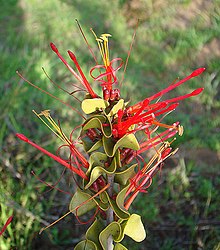| Tristerix | |
|---|---|

| |
| Tristerix corymbosus | |
| Scientific classification | |
| Kingdom: | Plantae |
| Clade: | Tracheophytes |
| Clade: | Angiosperms |
| Clade: | Eudicots |
| Order: | Santalales |
| Family: | Loranthaceae |
| Genus: | Tristerix Mart. |
| Species | |
Tristerix is a genus of mistletoe in the family Loranthaceae, native to the Andes, ranging from Colombia and Ecuador to Chile and Argentina. They are woody perennials usually occurring as aerial parasites, are pollinated by hummingbirds and flowerpiercers, with seed-dispersal generally by birds but occasionally by mammals (Dromiciops). The genus is distinguished from other New World Loranthaceae by its simple, terminal, racemose inflorescences, together with its of 4- or 5-merous flowers, versatile anthers, and the presence of endosperm. Further differences include fused cotyledons and the absence of epicortical roots.

Phylogeny
Tristerix was first described in 1830 by Martius, who published three species: T. viridiflorus (now Macrosolen viridiflorus, T. tetrandus (now T. corymbosus) and T. reinwardtianus (now Macrosolen avenis). In 1868, Eichler placed Loranthus aphyllus and L. tetrandrus in the genus Phrygillanthus. However, in 1973, Barlow & Wiens recognised these two Phrygilanthus species as Tristerix aphyllus and T. corymbosus, respectively, returning Tristerix to use.
Martius described the genus as having three bracts. However, this characteristic applies to only two species of the genus (T. aphyllus and T. corymbosus). In these, two bracteoles inside a primary bract lie below the ovary. The other members of the genus have no bracteoles. Van Tieghem (1895) divided the genus into two subgenera; those species without bracteoles - Metastachys (with 9 species), and those with bracteoles - Tristerix (with 2 species - T. aphyllus and T. corymbosus). This division is accepted by Kuijt.
A phylogenetic study of 10 Tristerix species by Amico et al. (2007) found evidence for three groupings. A simplified consensus cladogram of their conclusions, from analyses which used two different character sets and three methods (maximum likelihood, minimum parsimony, and Bayesian inference) for finding the tree, is given below. Note that the grouping of the Tristerix species with bracteoles remains.
| |||||||||||||||||||||||||||||||||||||||||||
See

References
- ^ von Martius, C.F.P. 1830. Flora 13(1): 108. 1830. Regensburg.
- ^ Kuijt J (1988) Revision of Tristerix (Loranthaceae). Systematic Botany Monographs 19, 1-61.Kuijt, Job (1988). "Revision of Tristerix (Loranthaceae)". Systematic Botany Monographs. 19: 1–61. doi:10.2307/25027693. JSTOR 25027693.
- ^ Amico, GC, Vidal-Russell, R, Nickrent, DL (2007) Phylogenetic Relationships and Ecological Speciation in the Mistletoe Tristerix (Loranthaceae): The Influence of Pollinators, Dispersers, and Hosts. American Journal of Botany 94, 558-567.doi:10.3732/ajb.94.4.558
- Eichler, A.W. 1868. Flora Brasiliensis 5(2): 47. Vol. v.5, pt.2. 1866.
- Barlow, B.A. & Wiens, D. 1973. The classification of the generic segregates of Phrygilanthus (= Notanthera) of the Loranthaceae. Brittonia 25, 26. doi:10.2307/2805488 (p.39̟)
- van Tieghem, P. 1895. Sur Le Groupement Des Espèces En Genres Dans Les Loranthées A Calice Dialysépale Et Anthères Oscillantes Ou Struthanthées. Bulletin de la Société Botanique de France 42(2): 161–180. doi:10.1080/00378941.1895.10830585 Van Tieghem, M. Ph. (1895). "PDF". Bulletin de la Société Botanique de France. 42 (2): 161–180. doi:10.1080/00378941.1895.10830585.
- Romina Vidal-Russell and Daniel L. Nickrent (2007). "The biogeographic history of Loranthaceae" Archived 2012-09-23 at the Wayback Machine, DARWINIANA 45(suplemento) 34-54.
- Guillermo C Amico and Daniel L Nickrent (2009). "Population structure and phylogeography of the mistletoes Tristerix corymbosus and T. aphyllus (Loranthaceae) using chloroplast DNA sequence variation", American Journal of Botany 96:1571-1580. doi:10.3732/ajb.0800302
External links
- Govaerts, R. et al. 2018. Tristerix in Kew Science Plants of the World online. The Board of Trustees of the Royal Botanic Gardens, Kew. Published online. Accessed 4 April 2018.